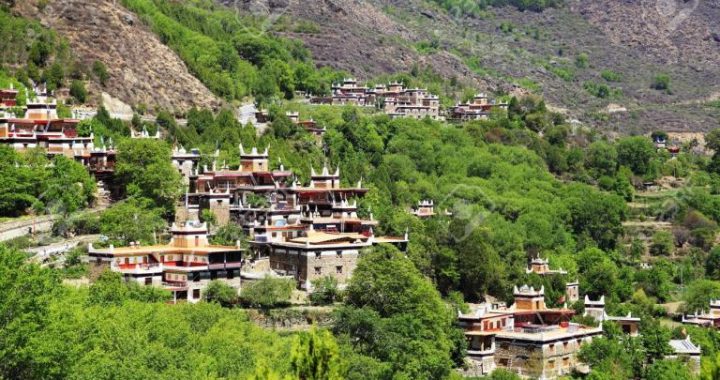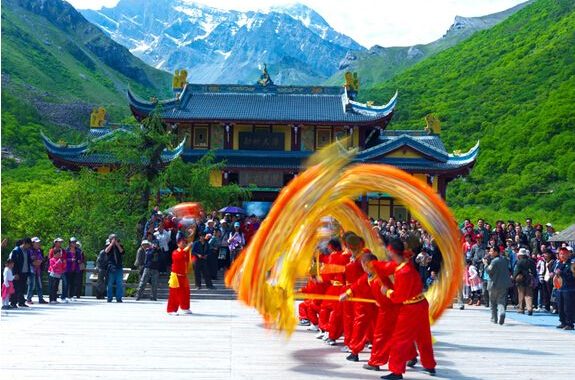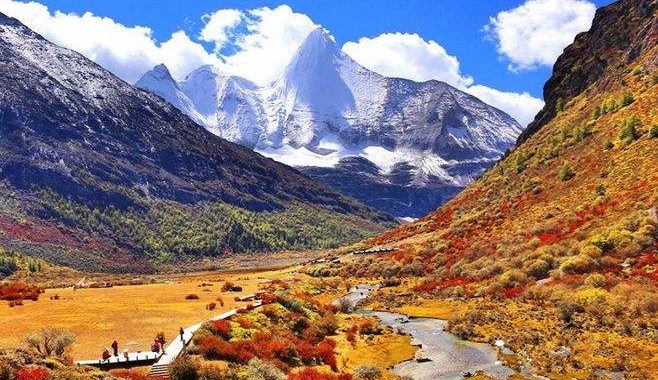Huanglong
3 min readPraised for its colorful limestone ponds,Huanglong(huang long),which means Yellow Dragon Mountain,lies in the south part of Min Shan in Songpan County.Situated in the northwest of Sichuan Province and 79 miles(128 km)south of Jiuzhaigou,the HuanglongValley is edged by snow-capped peaks and glaciers.An incredible biodiversity of flora andfauna thrives here alongside spectacular limestone formations,waterfalls and hot springs.

The area also has a population of endangered animals,including the giant panda and the Sichuan golden snub-nosed monkey.
Making it onto the UNESCO World Heritage Site listings in 1992,Huanglong is sectored into two gorges,Huanglong and Muni(mouni).The Huanglong part of the park is watered by tributaries of the Fujiang River,which run down Snow Mountain Ridge,feeding hundreds of small lakes and ponds.The rocks on the valley’s sides have been twisted into weird shapes by snow and rain,as have the rocks lying beneath the clear lake water.Most visitors first concentrate on the Huanglong section of the park.Dotted with ponds and patterned like a dragon,Huanglong Valley cuts its way through Min Shan.

More than half of the Huanglong zone is forested,with mountain pines mixing with broadleaf trees,flowers,shrubbery and meadow grasslands.Sitting atop the parkland,Snow Mountain Peak(xuebaoding)is permanently snow-covered and looks a daunting climb.

Equally daunting are the spectacular cliffs overhanging the Fujiang River’s drive through the Danyun Gorge(danyun xia).Algae and growth in the little lakes below turn the water a rainbow of colors:orange,yellow,green and blue.Other karst features include long limestone shoals,fan-shaped slopes of limestone deposited and covered by a thin layer of flowing water.
The Muni Gully(mouni gou )subdivision consists of two parallel small gullies,Zhaga(zhaga)and Erdaohai(edaohai).The hot springs in Pearl Boiling Lake(zhizha hu)simmer at 70F(21℃)in what amounts to a massively sized swimming pool.The waters of both springs have high mineral contents and are said to have important medicinal properties.Muni Gully also contains a number of very attractive lakes and the Zhaga Waterfall(zhaga pubu).

one of chengdu’s nost famous loveable citizens,the giant panda.
Because of its relatively pristine state,the forests at Huanglong are home to hundredsof bird species.On a walk into the higher reaches of the hills,away from the hordes of tourists below,one hears a cacophony of different birdcalls.Pandas meanwhile are found at four to five specific locations within the site,though visitors should tread carefully and slowly if they’re hoping to catch a glimpse.Much harder to spot is Sichuan golden snub-nosed monkey,an endangered species that hides out in Huanglong’s more undisturbed woodlands.

As in Jiuzhaigou,but perhaps with their presence even more low key,there are also plenty of indicators of Tibetan religion,culture and folklore in Huanglong.A pair of small stone pagodas stand near the entrance to the park that date from the Ming dynasty.
Nearby the Huanglong Temple(huanglong si)and the ruins of a much older temple still draw plenty of worshippers.Also in the vicinity,Body Washing Waterfall(xishen pubu)is said to have healing properties for those who bathe in its waters.

Huanglong Town is a medium sized Tibetan village close to the center of the main Huanglong subdivision.Local Tibetan herdsmen grazing their livestock and cultivating the land nearby make for great subjects if you’re slinging a camera.The larger town of Songpan(songpan)cuts Huanglong off from the Muni gully subdivision and is worth exploring in its own right if only for its stout town walls,Tibetan architecture and colorful vitality.
It’s also a good spot for souvenir hunting.




